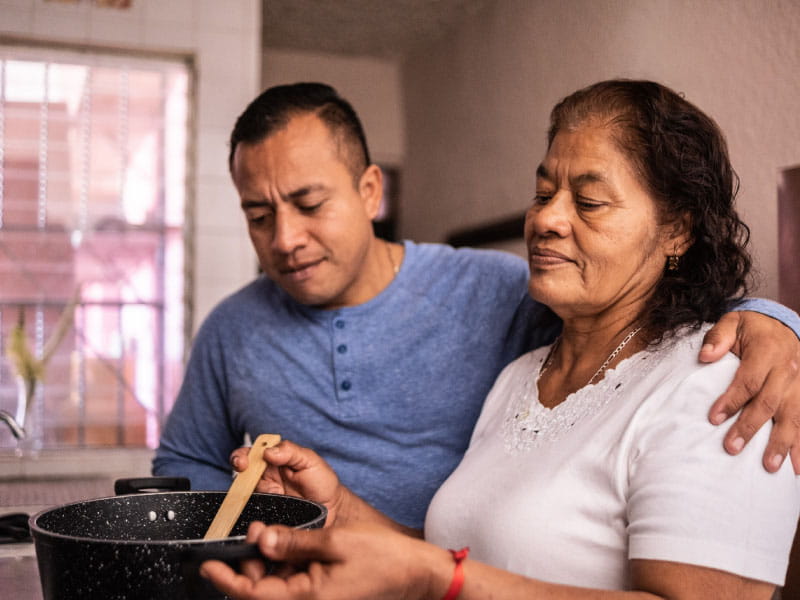Latin dishes can be heart-healthy and still keep authentic flavors
By Lourdes Medrano, American Heart Association News

Over the decades, traditional Latin American and Caribbean foods and flavors have won the hearts – and stomachs – of hungry people in the United States.
With every immigrant culture from Latin America and the Caribbean have come a cornucopia of foods that have increasingly tickled palates. Sure, the mere mention of staples such as tacos, enchiladas, arepas, empanadas, pupusas and tamales can conjure up images of dishes laden with salt, unhealthy fats and dense calories – ingredients that can contribute to cardiovascular disease. But it doesn't have to be that way.
It's possible to cook healthier while staying true to authentic culinary exports from Mexico, Venezuela, Colombia, Cuba, Puerto Rico and their neighbors. Preparing your own dishes is key, said Maggie Jiménez, a lifestyle and cooking personality on the Univision network in the U.S. "It's important to cook at home because you can control the ingredients and the amount of salt and oils you use."
Gabby Puche, a registered dietitian nutritionist in Tulsa, Oklahoma, agrees. For starters, eating out less frequently is a great first step, she said, because restaurants "first give you the tortilla chips, then they bring you a big platter with rice, beans, even tortillas. We just have to be careful with so many starches."
Traditional Latino dishes use many healthy ingredients, and the more they adhere to their roots, the healthier they are, Puche said. For example, she points to the mostly plant-based foods people consume in Nicoya, Costa Rica, one of five "blue zone" communities worldwide. Their residents enjoy optimal health and longevity.
"It embodies what a lot of Latin cuisines have, which is a diet that is rich in beans, legumes like black beans, red kidney beans, avocado, colorful vegetables like all the pepper varieties, tomatoes, yams, plantains – and they do eat the leaner choices of protein, like fish and chicken," Puche said. "All these staples are true to Costa Rica, but they're also true to the rest of Latin America."
But how food is prepared makes a huge difference, Jiménez said. That's why prioritizing cooking your own dishes with natural, unprocessed ingredients is key.
Transitioning to healthier ingredients is something Jiménez knows about. She once used salt excessively in her Mexican dishes. High amounts of sodium can harm health, including contributing to high blood pressure. In Jiménez's case, it resulted in kidney stones that sent her to the hospital. "I would wake up extremely swollen – my eyes, my hands. Everything was very swollen," she said. "It was very painful."
After she recovered, Jiménez replaced the excess salt with herbs and spices, such as powdered garlic, onion, cilantro and oregano.
Latino food staples, she said, also can be made healthier simply by not frying them in oil or lard, which can have a lot of saturated fat. Eating too many foods high in saturated fat can lead to elevated cholesterol levels and a higher risk of heart disease, according to the Centers for Disease Control and Prevention.
Jiménez suggests using an air fryer to cook chicken and other dishes when possible. And instead of submerging tortillas in hot oil on the stovetop, place them in the oven to turn them crispy for tostadas.
If cooking with oil is a must, Jiménez and Puche recommend sticking to olive, avocado and canola oils. But they stress that it's important to pay attention to quantity. Practicing portion control can go a long way toward healthy eating, Puche said, and that includes cooking oils. "One serving is two tablespoons, but people typically don't measure how much they're putting in their dishes."
It can happen with any entrée. Take arepas, a corn-based cake popular in South American cuisine, primarily Venezuela and Colombia. They're healthier baked than fried, and stuffed with small portions of lean chicken, beef and vegetables. "Arepas have plenty of fiber that helps with keeping cholesterol levels down," Puche said. "But portion matters even if the food is healthy."
To clients she counsels online, she recommends enjoying a reina pepiada, an arepa with lean chicken breast, avocado, tomato, cilantro and onion. "Yes, avocados are high in fat, but they're high in monounsaturated fat acids, which are healthier compared to the other arepas that have beef, cheese and grease," she said. Pupusas, the national dish of El Salvador, are similarly nutritious corn-based patties that can be stuffed with lean, healthier ingredients.
Puche pointed to evolving research touting healthy fats as foods that boost health, but she said it's still important to consider quality and quantity. "There are other populations across the world, for example, in the Mediterranean, they eat a higher fat diet and have little incidence of cardiovascular risk," she said. "So it really does matter, the quality of the fat."
A 2021 American Heart Association scientific statement on dietary guidance recommended the Mediterranean-style diet for its emphasis on whole grains, fruits, vegetables, plant-based fats and proteins from fish, seafood and lean meats.
Lean meats can make tacos healthier – even more so without heaps of cheese and sour cream – as can using more plant-based ingredients in Latino dishes, Puche said.
Access, availability and affordability can make it difficult for people to cook with top cuts of lean meat. But they can turn to nutritious items like beans, rice, fruits and vegetables that are usually within reach and healthier than eating out.
Those with a hankering for Puerto Rican food can replace salt with sofrito, a mixture of garlic, onions, peppers, tomatoes and fresh herbs used in soups, stews, beans and rice. "It's so healthy, has lots of fiber, it's simple to use and so economical," Puche said.
"It benefits you to cook at home – it does," she said. "It takes a little planning, but it can save money in the long run."





